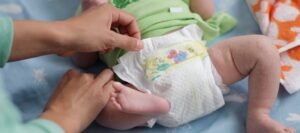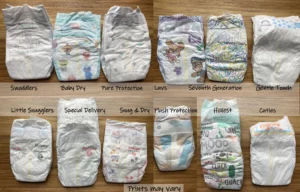
Choosing the right diaper is one of the first (and most frequent) decisions you’ll make as a parent. With dozens of brands, fits, and materials to choose from, it’s no wonder new parents feel overwhelmed. Between blowouts, diaper rash, and budget concerns, the pressure is real.
In this guide, we’ll break down how to choose the right diaper based on your baby’s size, age, skin sensitivity, and lifestyle. We’ll also share top recommendations (affiliate links included) to help you feel confident and prepared.
Why Choosing the Right Diaper Matters
A poorly fitting diaper can cause more than just a mess. The right diaper:
- Keeps baby dry and rash-free
- Prevents blowouts and leaks
- Saves you money by avoiding waste
- Protects sensitive skin from irritation
Whether you’re trying to prevent overnight leaks or avoid diaper rash, choosing the right type and size makes a huge difference in comfort for your baby and peace of mind for you.
Types of Diapers: Which One Fits Your Needs?
1. Disposable Diapers
- Convenient, easy to use, widely available
- Best for busy families or daycare use
2. Cloth Diapers
- Reusable, cost-effective long term
- Best for eco-conscious parents and sensitive skin
3. Hybrid Diapers
- Cloth shell + disposable insert
- Good compromise for flexibility and sustainability
4. Eco-Friendly Disposables
- Made without chlorine, fragrances, or latex
- Ideal for babies with sensitive skin
How to Choose Based on Your Baby
Age & Weight
Choose diaper size based on your baby’s current weight, not age. Diapers that are too big will leak, while diapers that are too small can cause red marks and discomfort.
Blowout Containment
Look for diapers with elastic waistbands, double leg gussets, and a snug (not tight) fit.
Skin Sensitivity
Choose fragrance-free, hypoallergenic options. Cloth or eco-friendly disposables are often better for rash-prone skin.
Overnight Protection
Use overnight-specific diapers or add a booster pad. These are more absorbent and designed to prevent leaks during longer stretches of sleep.
How to Tell If a Diaper Fits Correctly
A good diaper fit isn’t just about weight — it’s also about how it sits on your baby’s body:
- ✅ Flap Positioning: Many diapers have printed markings or characters on the front. The side tabs (or wings) should fasten symmetrically and land near these markers. If they barely reach or overlap too far, you may need to size up or down.
- ✅ No Red Marks: Check your baby’s thighs and waist after wearing the diaper. Red imprints mean it’s too tight.
- ✅ Snug but Comfy: You should be able to slip two fingers under the waistband comfortably.
Bonus Tip: The Yellow Line Trick
Most disposable diapers feature a yellow wetness indicator line on the front. When your baby pees, the line turns blue, so you don’t need to open the diaper to check if it’s wet. Super helpful in those early months!
Diaper Size Guide by Weight
| Size | Weight Range | Common Age Range |
|---|---|---|
| Newborn | Up to 10 lbs | 0–1 month |
| Size 1 | 8–14 lbs | 1–3 months |
| Size 2 | 12–18 lbs | 2–6 months |
| Size 3 | 16–28 lbs | 5–24 months |
| Size 4 | 22–37 lbs | 18–36 months |
| Size 5+ | 27+ lbs | 3 years and up |
🧼 Pro Tip: Always check for red marks around the legs or waist. That’s a sign your baby might need the next size up.
Pros & Cons: Cloth vs Disposable Diapers
| Cloth Diapers | Disposable Diapers | |
|---|---|---|
| Cost | Higher upfront, lower over time | Ongoing cost per diaper |
| Convenience | Requires washing | Easy to use and toss |
| Skin Sensitivity | Often better for rashes | Can contain fragrances/dyes |
| Environmental Impact | Eco-friendly, reusable | Single-use, landfill waste |
Diaper Mistakes to Avoid
- ❌ Sizing by age instead of weight
- ❌ Using wipes with alcohol or fragrance on sensitive skin
- ❌ Ignoring red marks or frequent leaks
- ❌ Not using nighttime diapers for long stretches of sleep
Our Top Diaper Recommendations
| Need | Product | Affiliate Link |
|---|---|---|
| Best for Newborns | Pampers Swaddlers for a soft, flexible fit | See Newborn Pick |
| Best for Blowout Protection | Huggies Little Snugglers with secure leak-lock barriers | Try for Leak Defense |
| Best for Sensitive Skin | Honest Company hypoallergenic, plant-based diapers | Shop Sensitive Choice |
| Best Overnight Option | Pampers Baby-Dry for overnight dryness and comfort | Grab Overnight Pick |
| Best Cloth Diaper Starter Kit | ALVABABY reusable kit with adjustable snaps and inserts | Start Cloth Kit |
| Best Eco-Friendly Disposable | Bambo Nature chlorine-free, eco-certified diapers | Eco-Conscious Choice |
FAQs
How do I know if a diaper fits right?
It should be snug (but not tight) at the waist and thighs, with no red marks. You shouldn’t be seeing frequent leaks or gaps.
Should I choose cloth or disposable?
Cloth saves money and is eco-friendly, but disposables offer convenience. Many parents use a mix.
How many diapers does a newborn need per day?
Newborns typically need 8–12 diaper changes per day.
Which diapers are best for sensitive skin?
Look for fragrance-free, hypoallergenic diapers like Honest Company or Bambo Nature.
Can I use the same diaper brand overnight?
Some brands offer overnight-specific diapers that hold more liquid and prevent leaks.
Final Checklist
Before choosing your baby’s diaper, make sure it:
- ✅ Matches their current weight (not just age)
- ✅ Is free from fragrances and irritants (especially for newborns)
- ✅ Offers overnight protection if needed
- ✅ Has good leg gussets and waist fit
- ✅ Comes from a trusted brand (see our picks above)


